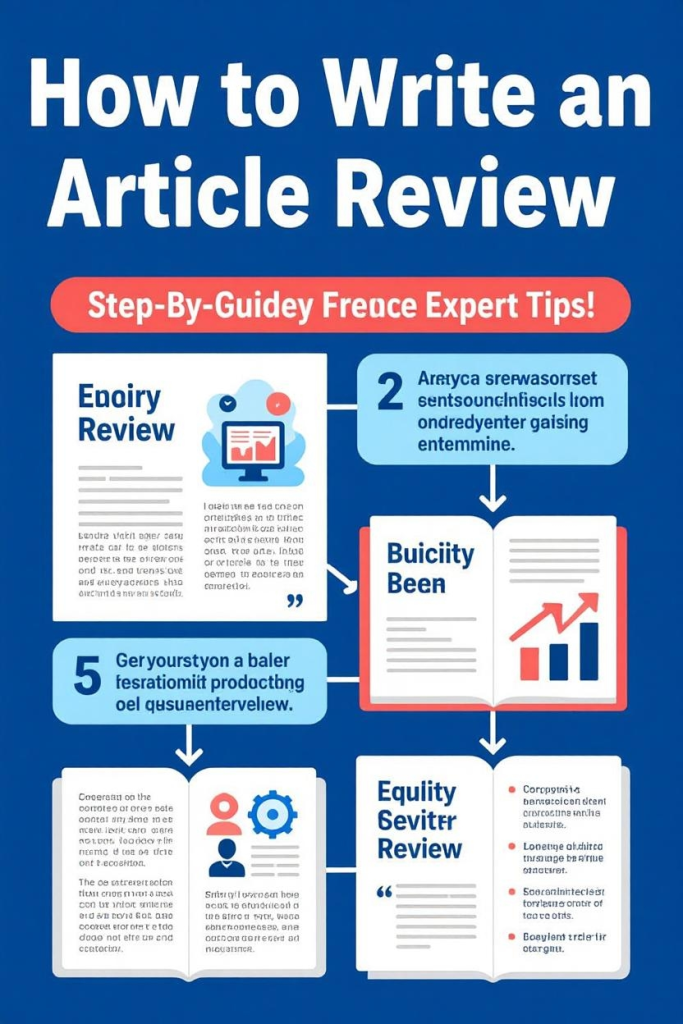
- What Is an Article Review?
- Step-by-Step Guide: How to Write an Article Review
- Writing a Strong Introduction
- How to Summarize an Article Effectively
- How to Critically Evaluate an Article
- Helpful Writing Tips for Students
- Article Review Template (APA Example)
- Common Mistakes to Avoid
- Final Thoughts on the Review-Writing Process
- FAQs on Writing Article Reviews
Introduction
Writing an article review is one of the most valuable academic skills every college student should master. It teaches you how to analyze research critically, summarize complex ideas clearly, and present your evaluation in a structured, scholarly manner. Unlike a simple summary, an article review requires you to assess the author’s methods, findings, and contribution to the field. Whether you’re reviewing a journal article, scientific study, or literature paper, understanding the proper format and approach can make all the difference. In this guide, you’ll learn step-by-step how to write an article review that meets academic standards, follows APA guidelines, and demonstrates strong critical thinking—helping you achieve higher grades and stronger writing confidence.
What Is an Article Review?
An article review is a form of academic writing that evaluates and analyzes a scholarly or research article.
Unlike a regular summary, an article review requires critical thinking — you don’t just restate the author’s ideas; you examine methods, findings, and their contribution to the academic field.
Students often write article reviews in college and graduate school to:
- Develop analytical and critical reading skills
- Understand how academic arguments are structured
- Learn how to identify the strengths and weaknesses of a study
Simply put, writing an article review teaches you how to think like a researcher.
Why Do Students Write Article Reviews?
Students write article reviews to strengthen their analytical, critical thinking, and academic writing skills. This assignment goes beyond summarizing a text—it challenges learners to evaluate research quality, identify key arguments, and understand how scholarly evidence supports a thesis. Through article reviews, students learn how to assess a study’s credibility, recognize gaps in the research, and explore how findings contribute to existing literature. In addition, article review writing helps students become active participants in academic discussions rather than passive readers. It trains them to question information, compare viewpoints, and develop their ability to communicate complex ideas logically and persuasively. Professors often assign article reviews to test a student’s understanding of research methodology, citation practices, and the ability to write in a formal academic style. Ultimately, the purpose of writing an article review is to prepare students for higher-level research tasks—such as literature reviews, dissertations, or scientific reports—by building a foundation in critical reading and scholarly evaluation. At Essayassists, we emphasize that review writing is more than summarizing — it’s about engaging deeply with academic literature and presenting your interpretation with scholarly integrity.
Step-by-Step Guide: How to Write an Article Review

Here’s a complete “Step-by-Step Guide: How to Write an Article Review” section written in the detailed, student-friendly Essayassists.com style — clear, SEO-optimized, and easy to follow:
Step-by-Step Guide: How to Write an Article Review
Writing an article review may seem challenging at first, but with the right structure and process, it becomes an opportunity to demonstrate your understanding of academic research. The goal is to evaluate the article’s content, assess its validity, and explain how it contributes to the field. Follow these simple steps to master the art of writing an effective article review:
Step 1: Read the Article Thoroughly
Before writing, read the selected article several times. The first reading should give you a general understanding of the topic, while the second should focus on details such as the main argument, methodology, and key findings. Highlight essential points, take notes, and underline any terms or ideas you need to research further.
Ask yourself:
- What is the main purpose of the article?
- Who is the intended audience?
- What are the author’s main arguments and conclusions?
This deep reading helps you avoid summarizing blindly and prepares you for meaningful analysis.
Step 2: Identify the Main Thesis and Key Points
Once you understand the content, determine the author’s central argument (thesis statement). This is the foundation of the article and usually appears in the introduction or conclusion. Identify supporting points, examples, or evidence the author uses to back up their argument.
By pinpointing these elements, you’ll be able to explain the article’s main message clearly in your summary and evaluate whether the argument is logical and well-supported.
Step 3: Write a Concise and Objective Summary
Your next step is to summarize the article in your own words. Focus on the main ideas, research methods, and findings, but avoid adding your own opinions or interpretations. The summary section should be factual and neutral, allowing the reader to understand the article’s content without having to read the original piece.
Tip: Use academic transitions like “The author argues that…”, “The study demonstrates…”, or “Findings reveal…” to keep your writing formal and clear.
Step 4: Critically Evaluate the Article
This is the heart of your review. In this section, assess the article’s strengths and weaknesses using evidence and reasoning. Consider questions such as:
- Is the research question clear and well-defined?
- Are the methods appropriate for the study’s purpose?
- Does the author provide reliable data and credible sources?
- Are there any logical gaps or biases?
Provide examples from the text to support your points. For instance:
“Although the article presents valuable insights on climate policy, it overlooks data from developing countries, which limits the study’s global applicability.”
A well-balanced critique demonstrates your analytical ability and understanding of academic research.
Step 5: Structure the Review Logically

A professional article review typically includes four main sections:
- Introduction – Introduce the article with its title, author, publication details, and a brief overview of the topic.
- Summary – Present the main points, research methods, and findings.
- Critique – Discuss strengths, weaknesses, and overall contribution.
- Conclusion – Offer a final assessment and suggest areas for improvement or future research.
Maintaining a logical flow ensures that your review is easy to follow and academically coherent.
Step 6: Format According to APA Guidelines
Always follow your instructor’s formatting requirements, usually APA 7th edition.
Here are a few key rules:
- Use 12-point Times New Roman font and double spacing.
- Include a title page with your name, institution, and date.
- Cite all quotations and paraphrased information using in-text citations.
- Add a References page at the end of your review.
Proper formatting not only shows professionalism but also prevents plagiarism and ensures your paper meets academic standards.
Step 7: Revise and Proofread Carefully
Before submission, reread your article review to check for:
- Grammar or punctuation errors
- Proper citation of all sources
- Logical flow between paragraphs
- Neutral, academic tone
You can also ask a peer or tutor to review your paper for clarity and consistency. A polished, error-free article review always leaves a better impression on your instructor.
✅ Essayassists Tip:
Take your time during the reading and planning stages. The stronger your understanding of the article, the more insightful your critique will be. Practice regularly, and soon you’ll find that article review writing becomes an effortless academic skill.
Writing a Strong Introduction
The introduction of your article review sets the tone for the entire paper.
Include:
- Full title of the article
- Author’s full name
- Publication details (journal name, volume, date)
- A brief statement of the article’s aim
Example:
“In the research article ‘Digital Behavior of Urban Teens’ by Lisa M. Harper, published in The Journal of Modern Sociology (Vol. 27, April 2022), the author explores how short-form video content impacts high school students’ concentration and academic habits.”
How to Summarize an Article Effectively
Summarizing an article effectively is a vital step in the review-writing process. This section allows you to present the author’s key ideas, methods, and findings in a clear, unbiased way. A good summary shows that you’ve fully understood the article while keeping your writing concise and objective. The goal is to give readers enough information to grasp the original author’s purpose without them having to read the entire article themselves. Start by identifying the main thesis or argument — what the author is trying to prove or explain. Then, outline the key supporting points, such as the research questions, methodology, and results. Mention only the most relevant details, like sample size, data collection methods, or major findings, and exclude minor information that doesn’t directly support the study’s purpose.
Always use your own words and maintain a neutral tone. Avoid inserting opinions or interpretations at this stage — the summary should focus solely on what the author said, not what you think about it. Use academic transitions like “The author explains…”, “The study reveals…”, or “The findings indicate…” to make your writing flow smoothly.
Example of an Effective Summary Sentence:
“In her 2023 article published in The Journal of Educational Psychology, Dr. Karen Liu examines the relationship between sleep quality and academic performance among college students, concluding that poor sleep significantly lowers concentration and memory retention.”
Finally, ensure your summary is balanced and proportionate — about one-third of your total article review length. This provides enough context for your critique while keeping the focus on analysis rather than repetition.
Essayassists Tip:
When summarizing, think like a researcher. Ask yourself, “If someone hasn’t read the original article, will they understand its purpose and findings from my summary?” If the answer is yes, you’ve written an effective summary.
To summarize like a professional:
- Identify the main thesis statement
- Paraphrase the supporting points
- Mention research design and findings
- Exclude your personal opinions
- Keep it short — around 30–40% of your review
.
How to Critically Evaluate an Article

Critical evaluation is the most important part of writing an article review. It demonstrates your ability to analyze, interpret, and form reasoned judgments about academic work. While the summary section focuses on what the author said, the critical evaluation examines how well the author presented, supported, and justified their argument. This is where you assess the article’s quality, credibility, and overall contribution to its field of study. Begin by analyzing the clarity and coherence of the thesis statement. Is the author’s main argument clearly stated? Does the paper maintain a consistent focus throughout? Next, assess the strength of the evidence used. Look at the types of data, examples, or sources the author relies on — are they relevant, current, and credible? Reliable studies usually cite peer-reviewed research, official statistics, or well-established theories.
Evaluate the methodology carefully. Was the research design appropriate for the author’s goals? For example, did the researcher use qualitative interviews when quantitative data was needed, or vice versa? Also consider whether the study sample, time frame, or analytical approach may have limited the results. Then, look at the article’s organization and structure. Are ideas presented logically, with smooth transitions and clear explanations? Does the author stay objective, or do personal opinions or biases appear? Academic writing should maintain neutrality and avoid emotional or persuasive language unless justified by evidence.
Example of Critical Evaluation:
“While Johnson’s article on remote learning effectively highlights the challenges faced by rural students, it fails to provide sufficient data from primary school levels, which weakens the general applicability of its conclusions.”
You can also discuss gaps or weaknesses in the research. For instance:
- Were any key variables ignored?
- Are there contradictions between the evidence and the conclusions?
- Could future research expand or clarify certain points?
Finally, evaluate the article’s overall contribution to its field. Does it introduce a new perspective, confirm previous findings, or challenge existing theories? A good critical evaluation acknowledges both strengths and weaknesses to provide a balanced academic assessment.
Essayassists Tip:
Use a constructive tone throughout your critique. Instead of simply saying “the argument is weak,” explain why and offer alternatives:
“The argument would be stronger if the author included comparative data or discussed socioeconomic differences among participants.”
By combining thoughtful analysis with evidence-based reasoning, your critical evaluation will demonstrate intellectual maturity and academic professionalism.
Would you like me to continue with the next section — “Helpful Writing Tips for Students” — in the same structured, SEO-optimized Essayassists tone?
- Analyze the logic and flow of arguments
- Comment on source credibility and data validity
- Identify biases, assumptions, or missing perspectives
- Discuss how the article contributes to the broader field
Example critique sentence:
“Although the article effectively highlights urban media consumption trends, it neglects rural populations, which could offer valuable comparative insights.”
Remember, critical evaluation doesn’t mean negativity — it’s about balanced analysis.
Helpful Writing Tips for Students
✅ Avoid personal language (“I think,” “In my view”)
✅ Use linking phrases for smooth transitions
✅ Check grammar and spelling before submission
✅ Ensure all paraphrased sections are cited
✅ Stay consistent with academic tone
Article Review Template (APA Example)
Introduction
- Title of the article
- Author’s full name
- Publication details
- Brief overview of the topic
Summary
- Main arguments
- Research methods
- Findings and results
Critical Evaluation
- Strengths and limitations
- Logical consistency
- Quality of evidence and sources
- Suggestions for improvement
Conclusion
- Restate your overall impression
- Summarize the article’s contribution
- Discuss its relevance to the field
Example conclusion:
“Overall, Harper’s article offers valuable insights into youth media consumption but would benefit from broader demographic sampling. Nevertheless, it contributes meaningfully to the growing literature on digital learning behaviors.”
Common Mistakes to Avoid
❌ Merely summarizing the article without analysis
❌ Ignoring formatting and citation rules
❌ Using informal or subjective tone
❌ Forgetting to mention publication details
❌ Plagiarizing or copying phrases directly
Final Thoughts on the Review-Writing Process
A well-written article review demonstrates critical engagement, clarity, and objectivity.
By carefully reading, summarizing, and evaluating, you transform from a passive reader into an analytical scholar.
Always proofread your final paper, ensure it follows APA guidelines, and check that your evaluation is evidence-based.
At Essayassists, we believe that every student can master academic review writing with structured guidance and consistent practice.
FAQs on Writing Article Reviews

1. What is the main purpose of writing an article review?
The main purpose of an article review is to critically evaluate another scholar’s work by summarizing its main points, analyzing its strengths and weaknesses, and assessing its overall contribution to the field. It allows students to practice critical thinking, academic writing, and research evaluation skills.
2. How long should an article review be?
An article review typically ranges from 600 to 1,200 words, depending on your instructor’s requirements and the complexity of the article. The key is to be concise yet thorough—summarize effectively, analyze critically, and avoid unnecessary repetition.
3. What format should I use for my article review?
Most college assignments require APA 7th edition format. This includes a title page, in-text citations, double spacing, 1-inch margins, and a references page. However, always check your professor’s instructions—some disciplines prefer MLA or Chicago style.
4. Can I include my personal opinion in an article review?
Yes, but only in the critical evaluation section. Personal opinions should always be supported by logic, evidence, or scholarly references. Avoid emotional or informal language—focus on academic reasoning and objective assessment.
5. How do I start an article review introduction?
Start by mentioning the title of the article, author’s name, and publication details. Then, briefly describe the main topic or research problem and state your overall impression of the article. Your introduction should clearly set up what the review will discuss.
6. How is an article review different from a summary?
A summary simply restates the main ideas of an article, while an article review goes further—it involves analyzing, evaluating, and critiquing the author’s work. Reviews also include your perspective on the article’s quality, organization, and contribution to the field.
7. What are the most common mistakes to avoid when writing an article review?
- Focusing only on summary without analysis
- Using informal or emotional tone
- Ignoring citation and formatting rules
- Forgetting to mention publication details
- Providing opinions without supporting evidence
Avoiding these mistakes ensures your article review remains scholarly and credible.
8. How do I conclude my article review effectively?
End with a short paragraph that restates your overall evaluation. Mention the article’s main strengths, weaknesses, and relevance to future research or practice. A strong conclusion leaves your reader with a clear understanding of your academic judgment.
9. Where can I find good examples of article reviews?
You can explore academic resources like Essayassists.com, Google Scholar, or university writing centers. These examples will help you understand structure, tone, and proper APA formatting for article reviews.
10. What skills can I develop by writing article reviews?
Writing article reviews enhances critical thinking, academic writing, research literacy, and analytical reasoning. It helps students engage with scholarly material more effectively and prepares them for advanced projects like dissertations and literature reviews.
Essayassists Tip:
When in doubt, always return to the basics—read the article carefully, write with objectivity, and support every argument with credible evidence. Strong academic writing is built on structure, clarity, and critical insight.
⭐ Need Expert Help?
If you’re struggling to write your article review or literature critique, let the Essayassists professionals guide you.
We offer:
- 100% original academic papers
- Free title page and bibliography
- Proofreading and formatting assistance
👉 Save your time — order your custom article review today!
